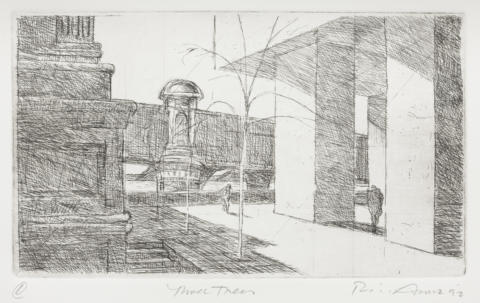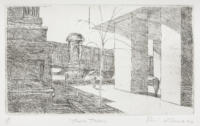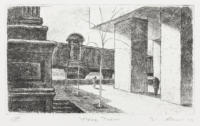
Etching. A view along a walkway between two buildings, looking towards a bridge; behind the section of the bridge’s span that is visible is a river, and beyond it a glimpse of its opposite bank. In the left foreground is the ornate corner of a nineteenth-century building, with steps to its basement, and at the right are the square pillars of a modern, Brutalist building. Lining the walkway are three bare saplings. To their right a figure is depicted walking towards the foreground, while another figure stands in the shadows of the building at right. The composition, which is lightly etched, is substantially complete in its detail. Ruled compositional lines have been etched across the plate and are clearly visible.
The sky has been partly covered with an area of loosely etched diagonal strokes. Short etched strokes have been added to the light areas of the building at right, and to the ground to the right of the trees. The lower part of the shading on the columns of the building at right has been burnished, while the underside of the building has been darkened with more hatching. The architectural details of the building at left have also been burnished, as has a small area of the bridge to the right of the building’s contour.
- Catalogue Number
- E.059
- Title and Date
- Three trees 1992
- Description of Featured Image
- A view along a walkway between two buildings, looking towards a bridge; behind the section of the bridge’s span that is visible is a river, and beyond it a glimpse of its opposite bank. In the left foreground is the ornate corner of a nineteenth-century building, with steps to its basement, and at the right are the square pillars of a modern, Brutalist building. The walkway is planted with a row of three saplings. To the right of these bare trees, a figure is depicted walking towards the foreground, while another figure stands in the shadows of the building at right.
- Where Made
- Dunmoochin, Cottles Bridge
- Medium Category and Technique
- Intaglio Print: Etching and burnishing on copper
- Support
- Wove paper. Identified papers: Fabriano paper with watermark: ‘CMF’ with star above, within a circle/oval.
- Dimensions
-
Image size: 153 x 205 mm
Matrix size: 153 x 205 mm - Artist’s Record Number
- RAE.52
- Printer(s) and Workshop(s)
- All impressions printed by Rick Amor in his Dunmoochin studio, Cottles Bridge.
- Summary Edition Information
- Five states. No edition.
- Collections
- State Library of Victoria, Melbourne: five state impressions, numbered 1 through 5.
- Comment
This is a composite view of various structures in Melbourne, including the Sandridge Railway Line Bridge, which crosses the Yarra River, and Collingwood Town Hall, in inner-suburban Collingwood (the source for the nineteenth-century building seen at left). E.059 is after a 1992 painting of the same title, although in reverse orientation. The painting, which was based on two drawings and several photographs, was exhibited in 1992, but was later destroyed by the artist. Amor also made a colour woodcut of the Three trees subject, again in 1992.
In developing the image in E.059, Amor worked through five states of the etching, clarifying architectural details and the rendering of volume, increasing the spatial coherence of the whole, and, above all, evoking a mood of urban alienation, whereby the city appears as hostile to nature as to humans.
The title of this print carries clear echoes of one of Rembrandt’s most famous etchings, The three trees, 1643; however, whereas Rembrandt depicts three hardy, mature trees, standing near the crest of a hill, Amor shows three denuded saplings, struggling for life in the city’s shade.
- Keywords
- Bridge, Cityscapes & streetscapes, Melbourne
- URL
- https://catalogue.rickamor.com.au/works/intaglio/three-trees/
Record last updated 10/07/2017


